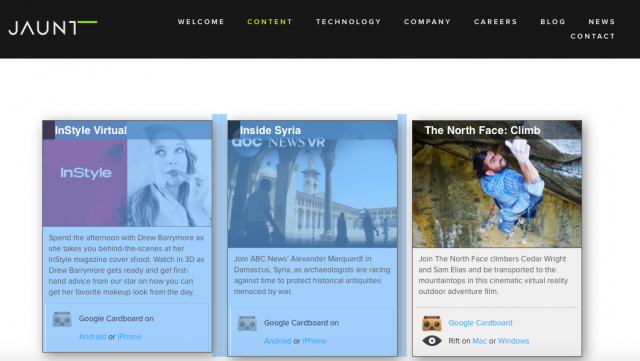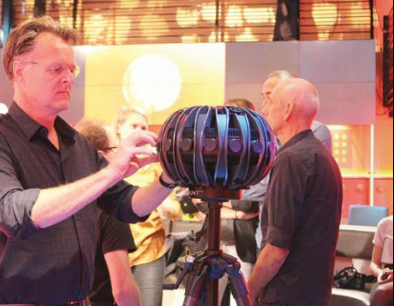Got a Google Cardboard VR for your smartphone and looking for content? Well probably not, but Palo Alto VR content Company Jaunt is looking to help drive demand for the new 360 degree display format. Its new 24 lens camera plus end to end solution is now being used so effectively to enhance the real world experience, it is gaining the interest of film makers, top musicians and even broadcast news professionals.

 Jaunt VR content page with feeds ranging from broadcast news to Sir Paul McCartney’s San Francisco ConcertThe 3D content creation solution promises to deliver professional grade 360-degree stereoscopic Virtual Reality content that could change the very way we experience video from news and information gathering, to film, entertainment and gaming. To get a sampling head over to the Jaunt content library for a look see.
Jaunt VR content page with feeds ranging from broadcast news to Sir Paul McCartney’s San Francisco ConcertThe 3D content creation solution promises to deliver professional grade 360-degree stereoscopic Virtual Reality content that could change the very way we experience video from news and information gathering, to film, entertainment and gaming. To get a sampling head over to the Jaunt content library for a look see.
The Jaunt One camera creates a 360-degree view of what Jaunt calls “computational” left and right eye recorded data that is ported to the cloud for processing. The output is a full 60 frames per second 3D stereo feed plus audio that is captured from all four directions to sync with the images. Getting the audio direction right is important to help deliver the immersion effect, according to the group.
 New VR Camera Jaunt One with 24 lens system delivering 3D stereoscopic VR feedsBuilt from the ground up with the intent to deliver “true 3D” that shows full stereoscopic images in all directions, the Jaunt One system uses a series of 3 camera lenses collecting data on a single field of view rather than the traditional one lens. “Every point in space has three lenses on it, that’s how we created a virtual camera,” said CTO Author van Hoff, who was quoted in a recent TV Technology article published this week.
New VR Camera Jaunt One with 24 lens system delivering 3D stereoscopic VR feedsBuilt from the ground up with the intent to deliver “true 3D” that shows full stereoscopic images in all directions, the Jaunt One system uses a series of 3 camera lenses collecting data on a single field of view rather than the traditional one lens. “Every point in space has three lenses on it, that’s how we created a virtual camera,” said CTO Author van Hoff, who was quoted in a recent TV Technology article published this week.
The Jaunt One (code name Neo) was officially announced back in June along with its post production and workflow enhancements that allow film makers to work with traditional tools including Avid, Premiere, Final Cut Pro X, Nuke, RV, Shotgun, Maya, 3Ds Max, After Effects, DaVinci Resolve, Assimilate’s Scratch, and Lustre to create the final product.
There’s no doubt the VR content production space is heating up, and even Google is getting into the space. We see this move more as an enabler until more companies like Jaunt (Matterport is another targeting Real Estate and more consumer level production) get a firm footing. Much like the cardboard VR viewer, Google has developed its own Jump camera rig system for VR content creation. It’s a far less sophisticated image capture device that uses 16 camera modules assembled in a circular pattern along with an “assembler” that transform those 16 video feeds into a stereoscopic VR feed. Google said its rig is sized specifically to optimize work with its assembler.
There’s no doubt VR content creation is moving into the pro space, but for now, Google Cardboard is the easiest way to get into the VR viewing side to take a look. I’m also betting we will be seeing low cost better quality display devices from companies like Mattel’s updated Viewmaster based on the Qualcomm Vuforia technology (Qualcomm sold that technology last week – Man Ed PTC to Acquire Augmented Reality Leader Vuforia from Qualcomm – subscription required). The technology might hit the shelves in time for holiday shoppers at the cutting edge (perhaps bleeding edge is more appropriate) So get ready for a whole new VR content and viewing experience coming soon. Steve Sechrist

